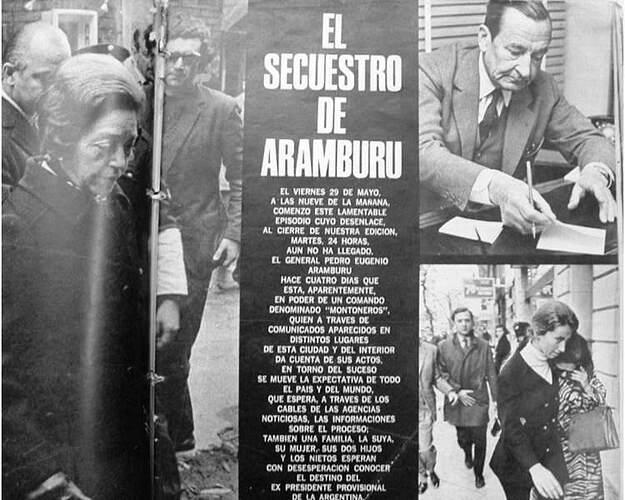The first Desaparecido:
Pedro Eugenio Aramburu Cilveti ([COLOR=black]May 21, 1903 – June 1, 1970) was a de facto president of Argentina from November 13, 1955 to May 1, 1958. He was kidnapped, “judged” and executed by the Montoneros guerrilla organization (the most extreme sector from the Peronism), in retaliation against the June 1956 Leon Suarez massacre and the execution of Juan José Valle.[/COLOR]
Born in [COLOR=black]Río Cuarto, Córdoba, he was one of the biggest exponents of the military sectors of 20th century Argentine society. His historical relevance was heightened by the fact that he confronted one of the biggest populist leaders in South America: Juan Domingo Perón.[/COLOR]
[ul]
[li]He studied in the Colegio Militar de la Nación [/li][li]1922: Sub-lieutenant [/li][li]1939: Major [/li][li]1943: Teacher in the Escuela de Guerra [/li][li]1951: Brigadier [/li][li]Director of the Escuela de Guerra [/li][li]1955: Chief Commander of the Army [/li][li]1958: Lieutenant general. [/ul][/li]After the first presidential succession (1958), Aramburu retired from military career and became part of Argentinian political life.
Then he ran for president in the elections of 1963, forming the political party “Union del Pueblo Argentino” (UDELPA, Union of the Argentine People), with an explicit slogan: “Vote UDELPA and HE won’t return” (“Vote UDELPA y no vuelve”), referring to Perón.
With Peronism prohibited, the Presidential elections proclaimed [COLOR=black]Arturo Umberto Illia as the new president, with the team of Pedro Eugenio Aramburu–Horacio Thedy winning only third place.[/COLOR]
Yet democracy was under military supervision, which maintained censorship of both Peronism and its leader. As a consequence of the fragile nature of the democratic process, Illia was quickly overthrown in 1966 by another military coup, led by General [COLOR=black]Juan Carlos Onganía.[/COLOR]
In all those 15 years, Pedro Eugenio Aramburu maintained a type of popularity, in newspapers and magazines. He was often consulted about his opinions on society and politics (especially in to the Gente magazine, representative of the high society of Argentina).
In 1970, he was even mentioned (again) as a possible Presidential successor.
Montoneros
In 1970 the rumours regarding [COLOR=black]Juan Domingo Perón’s return to Argentina grew daily. Still living in exile in Spain, his orders resonated stronger and stronger. At the same time, leftist ideologies grew in Argentina as in much of South America. The example of Che Guevara influenced a generation of students in schools and universities that widely supported international socialism.[/COLOR]
It was in this atmosphere that the [COLOR=black]Montoneros, led by Mario Alberto Firmenich were formed.[/COLOR]
It is possible that the Montoneros would not have had much social relevance had they not chosen such a resounding terrorist action, planning their first act of terror in the social-political life of Argentina. Their ambitious plan was the kidnapping and execution of former military president Pedro Eugenio Aramburu.
Death of Aramburu
On [COLOR=black]May 29, 1970 at noon, Aramburu was boldly kidnapped from the streets of [b]Buenos Aires[/b]. The disappearance of Aramburu kept the whole Argentinian society on tenterhooks for a month, before discovering that Aramburu had been murdered 3 days after his kidnapping, and that his corpse was left in a farm of the town of Timote, Carlos Tejedor, in the Buenos Aires.[/COLOR]
In the following months, official statements of the Montoneros flooded the media. Among other things they alleged historical reasons for their actions such as “the execution of 27 Peronist leaders after an unsuccessful Peronist rebellion in 1956”, known as the José León Suárez massacre.


